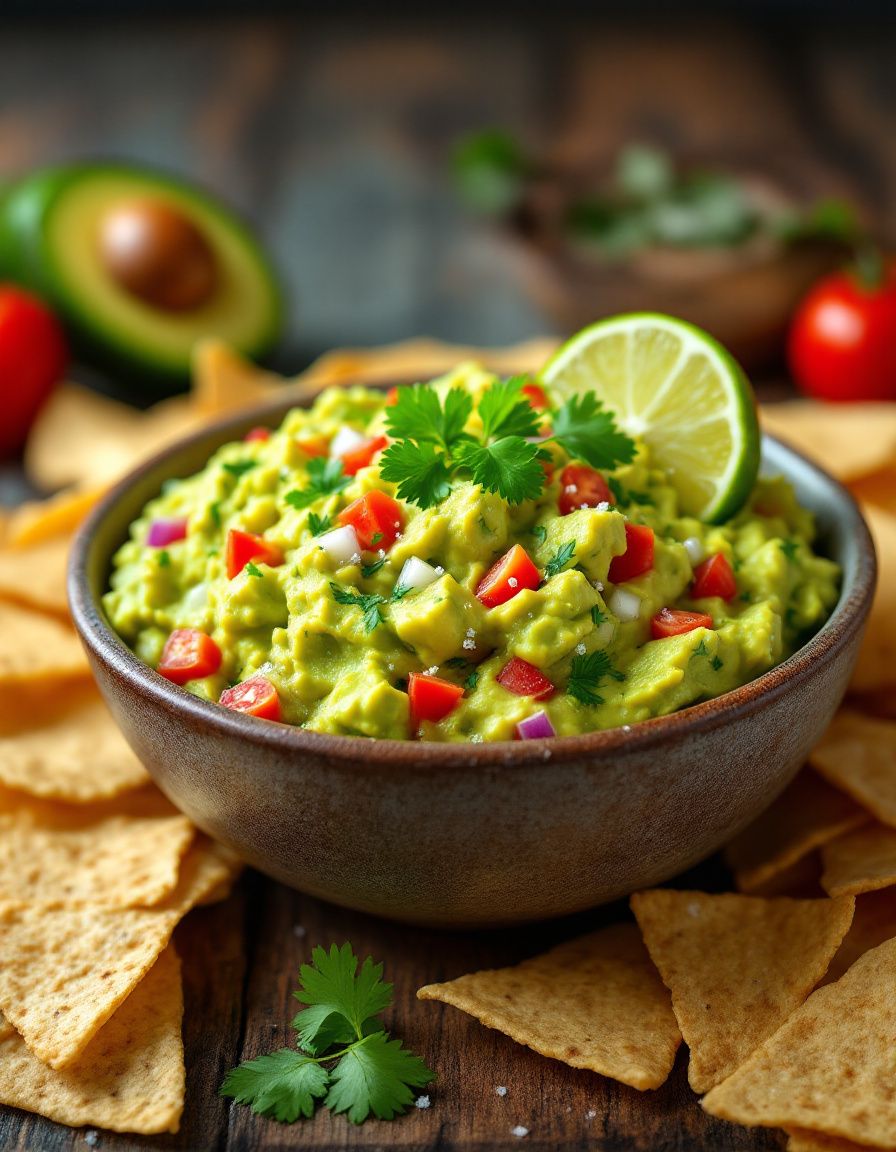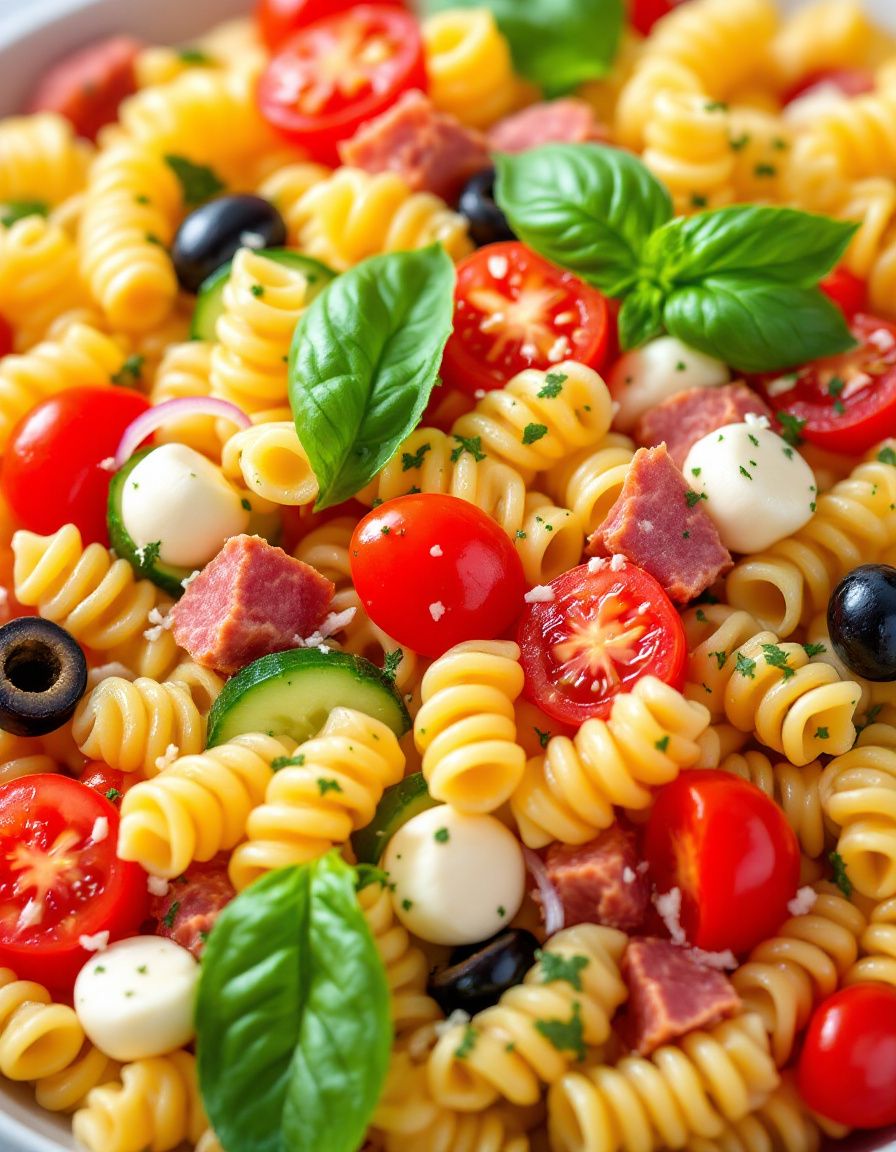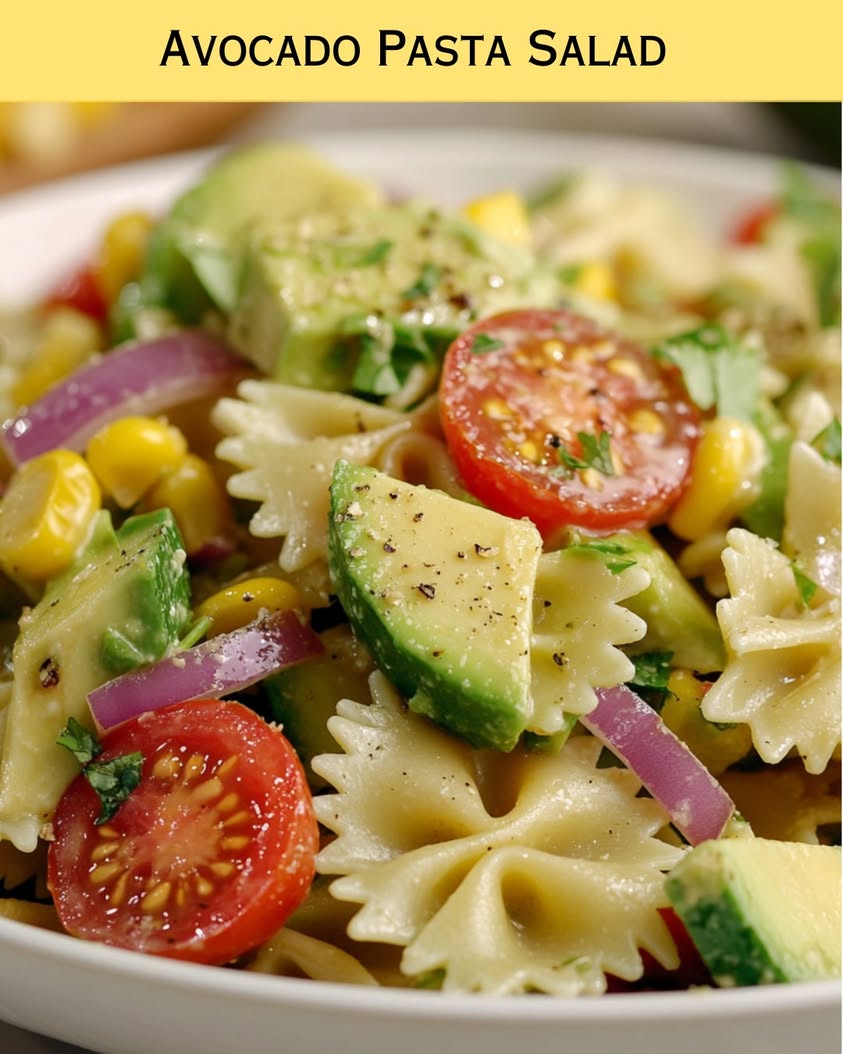Delicious Guacamole: A Flavorful Delight for Every Occasion
Guacamole is the ultimate appetizer that blends creamy avocado with vibrant flavors, making it a party favorite and a family staple. The moment you dip your chip into this green goodness, you’re greeted with a rich, buttery texture balanced by the zing of fresh lime juice and the savory crunch of diced onions. This classic Mexican dip not only captivates the taste buds but also brings joy and comfort to any gathering. Whether you’re hosting a lively fiesta or simply enjoying a quiet evening at home, guacamole is a delightful companion.
This recipe for guacamole is not only quick and easy but is also adaptable to your personal taste. You can enjoy it mild or spice it up with jalapeños, and it also pairs perfectly with various dishes from tacos to grilled meats. The versatility and freshness of ingredients available mean that you can prepare a batch in just ten minutes, which makes it an excellent choice for spontaneous get-togethers or game day snacks. Unleash the guacamole magic, and watch it disappear as your friends and family dive in for another scoop.
Quick Recipe Highlights
- Flavor Profile: The creaminess of avocado melds beautifully with zesty lime and aromatic cilantro, creating an irresistible blend of savory and fresh.
- Texture: This guacamole features a smooth and creamy base, punctuated with bits of crunchy onion and cilantro for a delightful contrast.
- Aroma: Experience the fresh and bright notes of lime juice combined with earthy undertones of avocado and herbaceous cilantro.
- Visual Appeal: The vibrant green hue of the avocado against the colorful specks of onion and cilantro makes for an eye-catching presentation.
- Skill Level Needed: With no cooking involved, this easy recipe is perfect for all skill levels, making it accessible to novice cooks and seasoned chefs alike.
- Special Equipment: All you’ll need is a good mixing bowl and a fork or a masher to combine the ingredients effortlessly.
Recipe Overview
- Difficulty Level: This guacamole recipe is easy, requiring no complex techniques or cooking skills, just mixing.
- Category: Perfect for appetizers, snacks, and nibbles at any mealtime or social gathering.
- Cuisine: Originating from Mexico, this dish showcases rich culinary traditions and flavors, highlighting the importance of fresh, local ingredients.
- Cost: Affordable, with avocados being the main cost, making it suitable for a budget-friendly gathering.
- Season: Best enjoyed during summer months when avocados are in season, but delicious year-round.
- Occasion: Ideal for parties, picnics, and as a side to grilled dishes, bringing a festive touch to any meal.
Why You’ll Love This Recipe
Guacamole is a tantalizing blend of taste and texture that keeps guests coming back for more. Each scoop is a fusion of rich flavor from the avocados, brightened by the citrus of lime, and brought alive with a hint of garlic and onion. As you savor this dip, the velvety creaminess wraps around your taste buds, invoking comfort and satisfaction — it truly is a delicious affair.
Convenience is another reason to love this guacamole. In just ten minutes, you can whip up a fresh batch that will elevate any meal or gathering. It’s a no-cook recipe, which means there’s minimal cleanup and less fuss in your kitchen—a true blessing for anyone short on time. Whether you’re hosting a barbecue or simply snacking during a movie marathon, this guacamole is readily available and adaptable.
Nutritionally, avocados are rich in healthy fats and packs essential vitamins and minerals, such as potassium and fiber. This guacamole not only serves as a delightful treat but also provides health benefits that align with a balanced diet. Enjoy guilt-free indulgence as you dip your tortilla chips or add it to your salads.
Sharing food, especially something as vibrant as guacamole, creates an inviting atmosphere that encourages conversation and connection. Whether you’re bringing dip to a potluck or serving it at home, this recipe adds excitement and a hint of festivity—it’s hard not to smile while enjoying this delightful concoction.
Finally, this homemade guacamole is extremely cost-effective. With just a few fresh ingredients, you have a crowd-pleasing dish without breaking the bank. Avocados are often available at reasonable prices, and you can customize the recipe to suit your wallet’s needs, ensuring that delicious guacamole is always within reach.
Historical Background and Cultural Significance
The origins of guacamole can be traced back to the Aztecs, who created a similar avocado mixture called “ahuaca-mulli.” This ancient dish was typically made with softened avocados mixed with onions, chilies, and lime juice. The history associated with guacamole highlights its importance in Mexican culture and cuisine over the centuries. The simple yet flavorful blend resonated with many, leading to its widespread popularity.
In Mexican culture, guacamole is more than just a dip; it represents gatherings, celebrations, and a sense of community. Traditionally served during holidays and festivals, this dish has become synonymous with social events. Its presence encourages sharing and fosters togetherness, placing it firmly as a staple in Mexican culinary tradition.
Over the years, guacamole has evolved as international cuisines have embraced it, leading to various interpretations. Different regions have developed unique combinations of ingredients based on local produce and flavor preferences. This evolution highlights the versatility of guacamole, allowing it to be customized to suit any palate.
From its humble beginnings to its rise as a global icon, guacamole has become a beloved ingredient in many dishes and served at celebrations worldwide. Its light-hearted flavor and ability to be paired with a wide range of foods only add to its cultural significance, cementing its place in the hearts of food enthusiasts everywhere.
Ingredient Deep Dive
Avocado is the star ingredient of guacamole, known for its creamy texture and rich flavor. This fruit is packed with healthy monounsaturated fats, which promote heart health and provide sustained energy. When selecting avocados, look for ones that yield slightly to pressure, indicating ripeness. Proper storage involves keeping them at room temperature until ripe, then refrigerating leftovers to prolong freshness. For substitutions, you can try using ripe, mashed bananas for a sweet twist, or even cooked sweet potatoes for a unique take.
Lime juice adds a vital zing to the guacamole, elevating its flavor profile. Rich in vitamin C and antioxidants, lime enhances both the taste and nutritional value of the dish. When choosing limes, look for those with smooth skin that feel heavy for their size. After juicing, store any unused lime juice in the refrigerator, or even freeze it in an ice cube tray for future use. Lime zest can also be used for added fragrance and flavor enhancement.
Cilantro, another key ingredient, infuses a fresh herbal note to the guacamole. This leafy herb is celebrated for its health benefits, including anti-inflammatory properties and vitamin K content. Look for vibrant green cilantro without wilting. When storing cilantro, trim the ends and place it in water in the fridge as you would with flowers. There’s also the option to substitute parsley if cilantro isn’t available, though the flavor will differ slightly.
Common Mistakes to Avoid
- Using unripe avocados: Select ripe avocados for a creamy texture. Unripe avocados can make your guacamole taste bland and difficult to mash.
- Over-mashing: While it’s tempting to achieve a silky texture, some chunks enhance the overall enjoyment. Mash to your preferred consistency, leaving some small pieces.
- Skipping lime juice: Lime juice preserves the avocado’s bright color and adds crucial flavor. Don’t omit it, as it enhances the freshness.
- Not seasoning adequately: Taste your guacamole as you make it, adjusting the salt, lime, and garlic to achieve balance.
- Including stems in cilantro: Ensure you only use the leaves of cilantro for flavor. Stems can be bitter and undesirable.
- Letting guacamole sit too long: Exposure to air causes avocado to brown. Serve promptly and store any leftovers properly to minimize browning.
- Using old garlic: Ensure your garlic is fresh. Old or dried-out garlic can impart a bitter flavor, negatively affecting your guacamole.
- Overloading with ingredients: While customization is great, too many additions can overwhelm the avocado. Stick to a few key flavors for a balanced taste.
Essential Techniques
When making guacamole, the primary technique is mashing the avocados. This is important for achieving the desired consistency—smooth but with some lumps. To master this skill, use a fork or potato masher. Be gentle when mixing in additional ingredients, allowing the flavors to blend without overworking the avocados. A common pitfall is over-mashing, which can result in a paste rather than the ideal chunky dip. Look for a creamy texture with visible bits of avocado for the best results.
Another essential technique is proper seasoning. It is crucial to taste and adjust as you go, especially with lime and salt. Start with small amounts, mixing thoroughly before adding more. This approach prevents overpowering the guacamole with too much acidity or saltiness. A visual cue for success is the bright green color; if it starts to dull or turn brown, you’re likely adding too much lime or resting too long before serving.
Pro Tips for Perfect Guacamole
To ensure perfect guacamole every time, start with ripe avocados. Press gently on the skin; it should yield slightly. If not ripe, leave them at room temperature until they do.
Use fresh lime juice instead of bottled for a brighter flavor. The acidity of fresh lime enhances the taste and keeps the avocado from browning quickly.
Chill your serving bowl in advance to keep the guacamole fresh and cool during serving.
For an extra kick, finely chop jalapeños and mix them in. Add them little by little to find your preferred spice level.
Enhance flavors with ground cumin or smoked paprika for a twist on traditional guacamole.
Serve guacamole with assorted dippers beyond chips, like fresh vegetables or toasted pita, for a colorful platter.
For easy storage, press plastic wrap directly onto the surface of the guacamole to reduce air exposure and prevent browning.
Fresh cilantro enhances flavor; add it at the end of the preparation for the best taste.
Variations and Adaptations
Guacamole is versatile and can adapt to regional tastes; for instance, adding diced tomatoes can create a fresher taste reminiscent of salsa. Southern-style versions often incorporate corn for a hearty bite, while Latin variants may include chilies for added spice.
Seasonal adaptations work wonderfully as well. In the fall, try incorporating diced roasted peppers for a smoky depth. During summer, go for local produce like fresh corn or diced mango for sweetness that complements the avocado.
For those on specific diets, dietary modifications can include swapping traditional ingredients for alternatives—using lime zest for lime juice in keto versions or replacing avocados with creamy tahini for a similar texture minus the fruit.
Flavor variations can include adding ingredients like bacon, feta cheese, or roasted garlic for unique twists. Experiment to find your perfect blend while still retaining the core avocado taste.
Lastly, consider presentation alternatives. Puppet out dip in avocado shells or serve it in hollowed-out bell peppers for interesting visual flair. Fun garnishing can include pomegranate seeds or diced radishes sprinkled on top for pops of color.
Serving and Presentation Guide
When serving guacamole, presentation is as important as flavor. Use a colorful bowl that contrasts with the vibrant green of the dip to visually attract guests. For a rustic feel, consider serving in the original avocado shell.
Garnish your guacamole with a sprinkle of fresh cilantro or diced tomatoes to add color and freshness. Serve it with a diverse range of dippers; think crispy tortilla chips, crunchy veggie sticks, or even pita bread.
Temperature considerations are key; serve guacamole chilled to counteract any possible browning. If you’re serving outdoors, consider keeping your guacamole in a bowl over ice to maintain freshness.
Portion control matters; provide guests with small bowls of guacamole alongside dippers, allowing everyone to enjoy the dip without double-dipping or contaminating the main dish. This thoughtful planning enhances the overall dining experience.
Wine and Beverage Pairing
Wine pairings for guacamole typically feature light, crisp whites such as Sauvignon Blanc, which complement the creamy richness of the avocado and brighten the overall flavor profile. Alternatively, consider a light Pinot Grigio for its refreshing acidity.
For non-alcoholic options, sparkling water with a wedge of lime offers a refreshing complement to the dish, cutting through its richness whilst enhancing the zesty flavors.
If coffee or tea is suitable alongside, opt for a lightly brewed herbal tea that won’t overpower the taste of the guacamole. Serve it chilled for best results.
When pairing beverages, aim for those that will refresh the palate. Avoid overly rich or heavy drinks that can mask the vibrant flavors of your guacamole, allowing it to shine on its own.
Storage and Shelf Life
To extend the shelf life of guacamole, store it in an airtight container as soon as possible. Ensure that no air can seep in, as this is what causes browning. If you have leftover avocado pit, you can add it into the container to minimize discoloration.
Refrigeration is key; guacamole can last 1-2 days in the fridge when stored properly. If it starts to turn brown, simply scrape off the top layer, and the flavorful green beneath will still be great.
For longer storage, consider freezing guacamole in ice cube trays. This way, you can portion out small servings for future snacking. Thaw in the refrigerator overnight before use, stirring well upon thawing to restore consistency.
Check for spoilage; guacamole that has any off-smell or has turned completely brown should be discarded. Otherwise, keeping it in optimal conditions can extend its delightful flavors.
Make Ahead Strategies
If you want to make guacamole ahead of time, prepare it just a day in advance. This keeps the flavors fresh without losing too much vibrancy. Store it in an airtight container, pressing plastic wrap directly onto the guacamole surface to reduce air exposure.
As for prep timelines, keep your ingredients measured and ready to go the day before so you can quickly combine them. If adding ingredients last-minute, consider chopping vegetables beforehand.
Quality is vital; waiting too long might affect texture, so enjoy it as soon as possible—after a day’s wait, you’ll again have vibrant and flavorful dip.
For an exciting addition, think about refreshing flavors such as diced mango or pomegranate seeds right before serving for a burst of freshness that keeps your guests tantalized.
Lastly, ensure you have all the elements prepared to assemble just before serving; this elevates the overall freshness of your guacamole.
Scaling Instructions
When scaling your guacamole recipe, adjustments are straightforward. To halve the recipe, simply measure the avocado, lime juice, and other additions accordingly, while retaining the same proportions for flavor balance.
If doubling or tripling, ensure you have a large enough mixing bowl to accommodate your ingredients. You may also need to use a better mashing tool to handle a larger quantity effectively.
Timing modifications may be unnecessary as the prep can still be completed within the same timeframe. If you’re preparing for a larger crowd, consider serving in multiple bowls to keep the presentation appealing.
Put aside thought for storage when scaling; larger batches may require more airtight containers to maintain freshness.
Lastly, remember that occasionally flavors may intensify in larger batches, so taste and adjust seasoning as you master copy proportions.
Nutritional Deep Dive
Examining the nutritional content of guacamole reveals a complex mix of macro and micronutrients. Avocados are rich in healthy fats, mainly monounsaturated fat, which is beneficial for heart health. The typical serving contains a significant amount of fiber, aiding digestion and providing a sense of fullness.
In terms of micronutrients, avocados deliver vitamins such as E, K, and folate. Lime juice adds a burst of vitamin C, further enhancing the nutritional value. Together, these nutrients contribute toward a healthier immune system and overall well-being.
Health benefits of eating guacamole include improved cholesterol levels, thanks to its healthy fat content; studies suggest that monounsaturated fats can lower bad cholesterol while raising the good. The presence of dietary fiber also promotes regularity, further aiding digestion.
Proper portion analysis is essential; while guacamole is nutritious, its caloric density can add up quickly. Stick to 1/4 cup servings to maintain balance while benefiting from its healthy fats and nutrients.
Lastly, as part of a weight management plan, use guacamole as a substitute for less wholesome fats like mayo; it enhances flavor while providing healthier options in various dishes.
Dietary Adaptations
For gluten-free options, guacamole is already a perfect choice served with gluten-free tortillas, vegetables, or corn chips. Individuals with gluten sensitivities can enjoy this dip without worry.
Dairy-free alternatives are natural here; guacamole contains no dairy, making it suitable for vegans and those avoiding lactose. Pair with plant-based dippers to maintain the healthfulness of the snack.
Low-carb enthusiasts will appreciate guacamole for its contribution of healthy fats without the excess carbs found in many snack options. Pair with cucumber slices or bell pepper strips for a fulfilling experience.
Keto dieters should rejoice in the avocado’s low carbohydrate content and high-fat profile. Use it generously within meals, enhancing burgers or salads without breaching carb limits.
Paleo eaters can trust in the whole food ingredients of guacamole, making it compliant with their dietary restrictions. Simply pair with fresh veggies to keep snacks healthy and uncomplicated.
For low-FODMAP diets, adjust the quantity of onion and garlic, or replace them with chives to maintain flavor without triggering discomfort.
Lastly, for other specific diets, such as vegan-vegetarians, guacamole serves as an excellent source of healthy fats and fittingly complements salads, tacos, or main dishes without containing animal products.
Troubleshooting Guide
If you encounter texture issues, such as overly creamy or pasty guacamole, ensure you mash the avocados properly while leaving some small chunks for desired consistency.
For an unbalanced flavor, taste and adjust seasonings, adding small quantities of lime juice or salt until the flavors align harmoniously. Avoid over-mixing, which can lead to a bland profile.
Temperature concerns arise when guacamole is served, potentially wilting the fresh ingredients. Keep bowls chilled, and if necessary, serve on ice to maintain temperature during parties.
Equipment challenges might involve the struggle to mash avocados smoothly; opt for a potato masher or fork depending on your preference and ensure ripeness for easy mashing.
If flavor falls short due to ingredient substitutions, adding additional lime or spices can enhance taste and restore a compelling profile.
Finally, timing adherence is crucial for optimal freshness. If your guacamole doesn’t taste as bright after a few days, discard it and prepare a new batch, as flavors diminish over time.
Recipe Success Stories
Community feedback has revealed that many enjoy tweaking this guacamole recipe by adding personal touches, such as incorporating pineapple for a tropical spin or adding spices for a personal flair, ensuring that each batch is unique to their taste.
Variations success stories often include the triumph of those who created their style through the introduction of hot peppers, resulting in fiery recipes that cater to spicy food enthusiasts, enhancing gatherings with extra zest.
Adaptation stories showcase how readers have used this guacamole recipe as a dip for fresh veggies and chips, becoming a dietary staple for health-conscious friends, transforming it into a mainstay at every gathering.
One reader suggested using guacamole as a filling for sandwiches, blending textures together while retaining its classic taste, which proved to be a delightful success.
For photography tips, many have shared that including fresh lime wedges or sprigs of cilantro makes for a colorful and appetizing photo that highlights the vibrant hues of the dish.
Frequently Asked Questions
Yes, you can make guacamole ahead of time. To keep it fresh, store it in an airtight container and press plastic wrap directly onto the surface to minimize air exposure. It’s ideal to consume it within 1-2 days for optimal freshness.
2. What can I do to prevent my guacamole from turning brown?
To prevent browning, add lime juice immediately after mashing the avocados and cover the surface tightly with plastic wrap, ensuring minimal air contact. Storing in an airtight container also helps.
3. Can I freeze guacamole?
Yes, you can freeze guacamole in an ice cube tray or in a sealed container. For best results, use it within 3-6 months, and thaw in the refrigerator overnight before serving.
4. Is guacamole healthy?
Yes, guacamole is healthy as it contains avocados rich in healthy fats, fiber, vitamins, and minerals. However, watch your portion sizes, as it can be calorie-dense.
5. How do I ripen avocados quickly?
To ripen avocados quickly, place them in a brown paper bag with an apple or banana, as these fruits release ethylene gas, which speeds up ripening. Leave them at room temperature for a day or two.
6. Can I use dried spices instead of fresh ingredients?
While it’s best to use fresh ingredients for optimal flavor, dried spices can be used in a pinch. Adjust quantities according to taste, but keep in mind that fresh ingredients enhance taste and aroma.
7. What is the best way to serve guacamole?
Guacamole is best served chilled in a bowl with assorted dippers such as tortilla chips, colorful veggies, or even spread onto tacos. Consider adding garnishes for an appealing presentation.
8. How many avocados do I need for a large gathering?
For a large gathering, anywhere from 4 to 6 ripe avocados will typically suffice for a group of 10-12 people, assuming you serve it alongside other snacks.
9. Can I add other ingredients to my guacamole?
Absolutely! Feel free to experiment with additional ingredients like diced tomatoes, corn, jalapeños, or pineapple to create variations that suit your taste.
10. What is the best way to store leftover guacamole?
Store leftover guacamole in an airtight container with a layer of plastic wrap pressed directly against the surface. This prevents air exposure and minimizes browning.
Additional Resources
For related recipes, consider exploring dishes like pico de gallo or salsa verde for vibrant accompaniments to your guacamole.
Technique guides that focus on avocado handling or knife skills can also elevate your culinary skills and enhance your guacamole preparation process.
When it comes to ingredient information, discover local avocado varieties to find the best flavor profiles available in your area and the different health benefits they might provide.
Investing in quality kitchen tools, like a sturdy masher or mixing bowl, can facilitate easy preparation and enjoyable cooking experiences.
If you desire seasonal variations, consider how using local, in-season ingredients can lend unique flavors to your guacamole, making each preparation special.
Join the Conversation
Engage with us on social media by sharing your guacamole creations, using hashtags to connect with other food lovers.
For those interested in improving their food photography, get involved in recipe sharing communities where you can exchange tips and best practices while showcasing your best bites.
Your recipe reviews and feedback inspire us to continually improve; we love hearing your thoughts on our guacamole recipe and how it worked for you.
Feel free to suggest variations; we welcome contributions from our readers to share their inventive culinary twists on this classic dish.
Let’s come together to celebrate food—each scoop of guacamole represents not only a delicious dish but an experience shared with loved ones.
The Recipe
Guacamole
Serves: 4 servings
Prep Time: 10 mins
Cook Time: 0 mins
Total Time: 10 mins
Kitchen Equipment Needed
- Mixing bowl
- Fork or potato masher
- Measuring spoons
- Knife
- Cutting board
Ingredients
- 3 ripe avocados
- 1 lime, juiced
- 1 small onion, finely diced
- 1 tomato, diced
- 1 clove garlic, minced
- Salt, to taste
- Fresh cilantro, chopped (optional)
- Jalapeño, minced (optional, for spice)
Directions
- Cut the avocados in half, remove the pit, and scoop the flesh into a mixing bowl.
- Using a fork or potato masher, mash the avocados to your desired consistency.
- Add lime juice, diced onion, garlic, diced tomato, and salt to the mashed avocados.
- Gently mix all the ingredients until well combined.
- If desired, fold in chopped cilantro and minced jalapeño at this stage.
- Taste and adjust seasoning as necessary; adding more lime juice or salt to your liking.
- Transfer to a serving bowl and garnish with additional cilantro, if desired, and serve immediately.
Recipe Notes
- Store leftovers in an airtight container with plastic wrap pressed against the surface to minimize browning.
- Consider adding diced pineapple or corn for a unique flavor twist.
- This recipe is very adaptable; feel free to customize based on your preferences!




